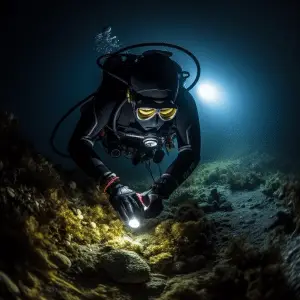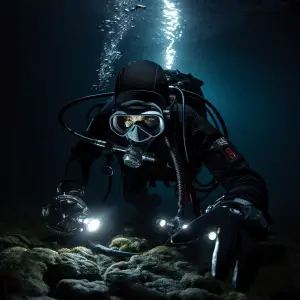Night diving is an amazing experience that offers divers the chance to explore the depths. But with no natural sunlight, there are safety considerations to take into account. Let’s look at these considerations and how divers can stay safe whilst enjoying night dives.
Visibility is reduced with no light. So, it’s important for divers to have proper training and experience before attempting night dives. Also, they should carry a reliable dive light to illuminate their surroundings and help keep their orientation.
Communication is also a key part of safety. In darkness, it’s hard to use visual cues. So, divers should use hand signals and flashlights to communicate with each other and their dive buddy. This helps ensure clear communication and keeps them safe.
Marine life behaviors also change at night. Some species become active while others hide. Divers must be aware of these changes and not disturb or provoke any creatures.
In a study by NOAA, some fish species were found to exhibit bioluminescence at night as a defense mechanism. It’s a beautiful sight, but divers mustn’t touch these glowing organisms as they play a vital role in maintaining oceanic balance.
Night diving brings its own challenges. But, with proper training, equipment and knowledge of safety considerations, divers can enjoy this unique adventure and explore the mysteries of the underwater world after dark.
Importance of Safety Considerations in Night Diving

As the sun sets, darkness engulfs the underwater world and night-diving brings a new dimension. Safety considerations are essential in night-diving and visibility is limited. Prioritize safety!
Navigate through the depths with heightened awareness. Rely on touch/hearing, and maintain buoyancy control. This prevents accidental contact with marine life and entanglement in obstacles.
A reliable source of light is essential for night dives. Illuminate surroundings to spot potential hazards and maintain orientation. Make sure dive lights are charged and have spare batteries.
Effective communication with dive buddy or guide is vital in this low-light environment. Use hand signals or communication devices. Clear and concise communication ensures safety.
Pro Tip: Familiarize with dive site during daylight hours. This allows you to acclimate to topography and identify potential hazards before venturing into the dark abyss.
Essential Safety Equipment for Night Diving
Night diving requires specific gear to ensure your safety. Here are five essential items:
- A strong dive light – helps you find your way and see your environment.
- A back-up light – in case the main light fails.
- Glow sticks or chemical lights – attach to your gear to help with communication.
- A whistle or other noise maker – sound travels better underwater.
- A surface marker buoy (SMB) – helps boats or divers locate you.
Also, consider gear with reflective or fluorescent properties. Dive computers with backlighting and anti-fog masks are also great ideas. Before a night dive, know about the safety features and how to use them.
Pre-Dive Planning and Preparation
To make night diving safe and enjoyable, plan and prepare carefully. These 4 steps are important:
- Research the dive site. Get info about the temperature, currents, visibility, and marine life. Learn of any hazards or special features.
- Check the equipment. Make sure your mask, fins, dive computer, regulator, BCD, and other gear work properly. Charge the flashlight or carry spare batteries.
- Buddy system. Never go alone. Agree on hand signals and communication methods with a reliable partner.
- Communication plan. Discuss emergency procedures in case you’re separated. Use signaling devices if needed.
Unique for night diving:
- Visibility is usually lower. Be ready to rely heavily on your flashlight.
Pro Tip: To save battery life, switch off the flashlight when not needed and use ambient light sources.
Night Dive Navigation and Orientation
Night dives bring specific challenges for navigation. Divers must utilize their senses and equipment to explore the underwater world in the dark. Here’s what to keep in mind:
- Column 1: Illumination Tools
- Column 2: Compass Navigation Techniques
- Column 3: Buddy System
- Column 4: Light Signals
In low visibility, specialized illumination tools such as dive lights or glow sticks are useful for navigation and also serve as visual markers.
Compass navigation is essential. Divers need to be familiar with using a compass and holding a heading in the dark.
Buddy system is even more important. Stay close to your dive buddy and communicate via hand or light signals. This ensures no one gets lost.
Light signals are special considerations for night diving. These allow divers to communicate with each other, sharing info or confirming their presence. Knowing these signals is essential for a safe night dive.
I recently went night diving, and encountered strong currents. Without our compass skills, we would have been lost. Our trust and light signals enabled us to get back safely. This reminded me of the importance of perfecting night dive navigation and staying aware underwater.
By following safety considerations and honing your skills, you can explore the nocturnal marine life while keeping yourself safe.
Dive Buddy Procedures
Night diving brings with it specific challenges. Visibility and orientation can be tough. So compass navigation techniques can help. Always use a primary and backup light source too.
My dive buddy and I were exploring a shipwreck in Indonesia. Then his flashlight fell into a crevice. We only had one functioning light. We had to signal each other with hand gestures and use our backup light.
This showed us the value of preparation and being able to adapt. Keep close to your dive buddy. Communicate well. Be ready for unexpected situations. You can then enjoy the underwater world after dark.
Dealing with Environmental Factors

Factor | Explanation
Visibility | Darkness reduces visibility, making divers use artificial light sources. This affects depth perception and makes it harder to swim.
Temperature | Water temperature drops at night, so divers must wear thermal protection such as wetsuits or drysuits to avoid hypothermia.
Marine Life | Nocturnal creatures come out at night dives, so divers can see fascinating marine life. But they must be careful, as some species may be more aggressive.
Bottom Conditions | Divers must make sure they have stable footing and not disturb the seabed. Kicking up sediment can reduce visibility.
Navigation | Without natural light, divers must use compasses, torches and plan before the dive to navigate correctly.
Pro Tip | Dive light practice is a must for night dives. Get familiar with its functions and improve your underwater experience.
Emergency Procedures and Contingency Planning
Table:
| Emergency Procedure | Description |
|---|---|
| Lost Buddy | Find a predetermined rendezvous point. Do a thorough search. Then, ascend safely. |
| Equipment Malfunction | Have a dive light, cutting tool, and spare mask ready. |
| Running Out of Air | Manage air consumption. Signal for help if necessary. |
| Decompression Sickness | Ascend slowly. Do the necessary decompression stops. |
| Entanglement | Carry a dive knife or line cutter. Don’t touch marine life. |
Night diving has extra considerations:
- Limited Visibility: Darkness limits your view. Have proper dive lights.
- Marine Life Behavior: Nocturnal animals might be more aggressive.
- Orientation Challenges: Without natural light, direction can be hard. Prepare for the dive site.
- Communication Difficulties: Low-light affects verbal communication. Use hand signals. Stay close to your buddy.
To dive safely at night, remember emergency procedures. Plan for contingencies. Enjoy this thrilling adventure safely. Dive smart!
Conclusion
It is key to have thorough preparation for a secure night dive. Start with a comprehensive equipment check, dive planning, and effective communication with your buddy.
Make sure lights are working, including primary and backup lights, as well as chemical and battery-powered signaling devices. This helps visibility and signals attention in case of emergencies.
Navigation skills become even more essential during night dives. Utilize reliable techniques like compass use or laid-down lines to avoid getting lost in the dark.
A true story illustrates the importance of being prepared. A group of divers explored a remote island at night. One diver’s mask strap snapped in the pitch-black water. Fortunately, they had their spare mask stored and continued the dive.
Frequently Asked Questions
1. Is night diving safe?
Night diving can be safe if proper safety considerations are followed. It requires additional skills and precautions due to limited visibility and potential hazards. Taking a night diving course and diving with a trained buddy are important to ensure safety.
2. What equipment is essential for night diving?
During night diving, essential equipment includes a primary and backup underwater light, dive computer or dive watch with a backlight, surface signaling device, compass, and a glow stick or chemical light. These help maintain visibility and communication in the dark.
3. How can I improve visibility while night diving?
To improve visibility during night diving, secure a light to your tank or wear a headlamp. Use a light with a focused beam to avoid scattering particles in the water. Dive in areas with minimal water movement to reduce sediment stirring up and affecting visibility.
4. What risks should I be aware of during night diving?
Some risks associated with night diving include disorientation, limited visibility, entanglement in marine life or equipment, and separation from your buddy or dive group. Being aware of these risks and practicing proper buddy communication and navigation skills can mitigate them.
5. How should I plan my dive for night diving?
Planning a night dive requires additional consideration. Check the weather, tides, and current conditions before diving. Plan for a shallower and shorter dive than during the day. Create a dive plan, including communication signals, and ensure you and your buddy have the necessary equipment and skills.
6. Are there any marine life considerations for night diving?
Night diving offers a unique opportunity to witness nocturnal marine life. However, some marine creatures are more active at night and may behave differently. Be cautious of certain nocturnal species, such as moray eels, as they may be more aggressive. Avoid touching or disturbing marine life during your night dives.
